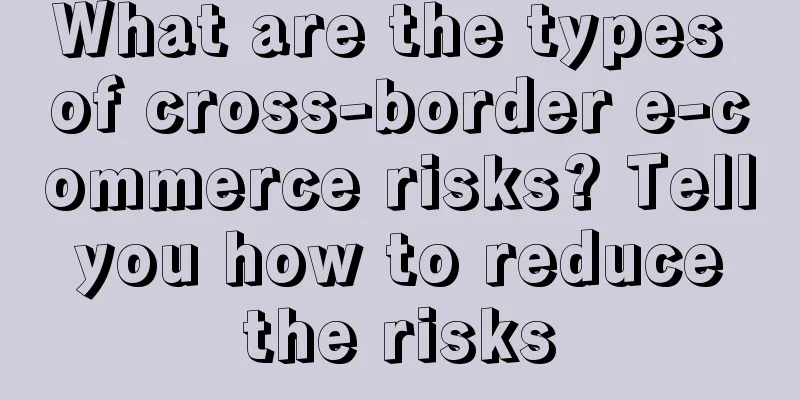What are the types of cross-border e-commerce risks? Tell you how to reduce the risks

|
With the progress of globalization, cross-border e-commerce has become the choice of more and more consumers and sellers. However, compared with traditional e-commerce, cross-border e-commerce faces some special risks. This article will discuss this issue and introduce how to reduce the risks of cross-border e-commerce. 1. What are the types of cross-border e-commerce risks? Cross-border e-commerce is an emerging business model that sells domestic goods to overseas markets through the Internet, thereby achieving cross-border trade. However, cross-border e-commerce also has some risks, mainly including the following types: Legal risks: Cross-border e-commerce involves the laws and regulations of different countries. If sellers do not understand the laws and regulations of the target market, they may face some legal risks, such as trademark infringement, intellectual property infringement, etc. Logistics risks: Cross-border e-commerce needs to transport goods to overseas markets through international logistics. Some risks may arise during the logistics process, such as loss, damage, and delay of goods. Exchange rate risk: Cross-border e-commerce involves currency exchange. If the exchange rate fluctuates greatly, it may affect the seller's profits. Market risk: Economic, political, cultural and other factors in the target market of cross-border e-commerce may have an impact on sales. If the market environment changes, it may affect the seller's business. Brand risk: Cross-border e-commerce needs to build its own brand. If the brand is not well-known, it may face some competitive pressure. 2. How to reduce the risk? To reduce the risks of cross-border e-commerce, sellers can take the following measures: Understand the laws and regulations of the target market: Sellers should understand the laws and regulations of the target market and avoid violating local laws and regulations to reduce legal risks. Choose a reliable logistics service provider: Sellers should choose a reliable logistics service provider to ensure that goods can be transported to overseas markets safely and promptly, thereby reducing logistics risks. Take exchange rate risk management measures: Sellers can take some exchange rate risk management measures, such as locking the exchange rate in advance, using foreign exchange derivatives, etc., to reduce exchange rate risks. Continue to pay attention to market dynamics: Sellers should continue to pay attention to the dynamics of the target market and adjust sales strategies in a timely manner to reduce market risks. Build your own brand: Sellers should build their own brand, improve brand awareness and reputation, and thus reduce brand risk. Cross-border e-commerce faces risks in logistics, payment security, intellectual property rights and market supervision. In order to reduce these risks, cross-border e-commerce should choose reliable logistics partners to ensure the safe transportation of goods; adopt safe and reliable payment methods, and strengthen buyer verification and risk assessment; protect intellectual property rights and safeguard them in a timely manner; understand and comply with relevant laws and regulations and standards. Recommended reading: Which platform should I choose for my personal cross-border e-commerce business? What are the requirements for entry? How much does it cost for personal cross-border e-commerce? Do I need a deposit? Can cross-border e-commerce personal trademarks be registered? What are the regulations? |
<<: Is Shopee a cross-border e-commerce platform? A detailed registration process
Recommend
Three situations of three "digging and digging kindergarten teachers"
"In what kind of garden, dig and dig, what ki...
After watching tens of thousands of videos, I summarized the 7 elements, 3 structures, and 5 steps of short video sales.
This article deeply analyzes the secrets of sellin...
Moutai ice cream targets “small town youth”
The article provides a clear analysis and insight ...
With an annual income of 20 billion, the snack version of Pinduoduo is hunting for county towns
Why are discount snack stores growing so fast in t...
This inconspicuous product sold over 100,000
What are the characteristics of hot-selling produc...
How does Lao Xiang Ji master marketing?
Lao Xiang Ji's "earthy marketing" is...
Does Amazon have no traffic for self-fulfillment? What are the ways?
Opening a store on Amazon also requires traffic. N...
Ten years of experience summary: 9 tips for international SaaS startups
Starting a business in the SaaS space is a difficu...
Category Adjustment of Alibaba International Station in October 2022
In order to optimize the product structure and enh...
What exactly is “marketing”?
We are all familiar with the concepts of marketing...
The new seven deadly sins of brand advertising have emerged! Are you guilty?
In recent years, advertising has become more and m...
What if Amazon requires a bank statement? What are the bank statement requirements?
Amazon platform sometimes verifies the seller'...
A brief history of Chinese milk tea conquering Europe
From tea leaves to milk tea, Chinese flavors have ...
What are the charging rules of the Lazada platform? How much is the commission of the Lazada platform?
As one of the largest e-commerce platforms in Sout...
What should I do if a Shopee customer gives me a 1-star negative review? How can I modify the negative review?
Domestic merchants who run stores on Shopee will a...









